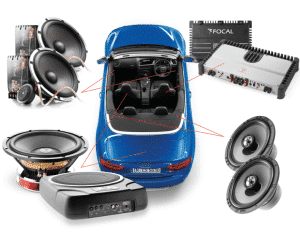Car Audio Basics: What is a car stereo system composed of?
In this post we are going to cover the basics of car audio. There are many things that go into a stereo setup, 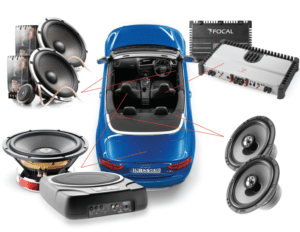 but they can be broken down into their basic components:
but they can be broken down into their basic components:
Source
The source is where your music comes from. This can be in the form of a CD, mp3 player, cell phone, etc. Basically what the music is stored on.
Signal Processor
For your music to play through the speakers, the signal first has to be processed. For CDs the signal processor is built into the CD player. For phones and mp3 players, the signal processor is usually built in to the phone/player itself. A signal processor takes the digital signal from your source and transforms it into something the amplifier will understand so it can be turned into sound.
Amplifier
After the signal is processed, it is amplified by either an external amplifier or the radio. Most head units are both a signal processor and an amplifier in one. This makes it easy to install aftermarket radios into otherwise stock cars since most cars have a basic radio with an amplifier built in. So really a head unit does both of these steps.
You can also add an external amplifier for cleaner and/or louder sound. This takes the signal from the radio or other signal processor in more advanced setups and amplifies it before sending it to the speakers to produce sound.
Speakers
Finally, the amplified signal makes its way through the speakers in the form of sign waves which produces the sound you hear that we call music (some better than others).
Car Audio Basics: How Does My Car’s Stereo Work?
Most Factory Car Audio Systems
Most cars come with a basic all in one head unit that acts as the signal processor and amplifier that sends that signal straight to the speakers. Since the signal processor is built into the cheap head unit, you usually can’t get good quality sound out of the factory setup without adding fancy external processors.
Amplified Factory Systems
Amplified systems are meant to sound good from the factory, but most of the time they don’t, and this usually complicates things. The way these systems work is the head unit acts as the signal processor that sends that signal to an external amplifier then to the speakers. Since these are meant to sound better than the all-in-one head unit setups, they usually do once you start adding your own components as well. But in some cases they end up sounding worse and expensive signal processors come into play.
Car Audio Basics: Upgrading and Optimizing Your Car Audio System
First Steps
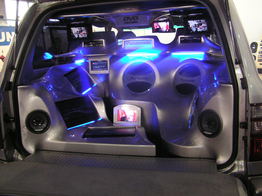
Start at the Source
When you are trying to get the best sound out of your system, you want to start at the source and work your way from there. The best speakers in the world will sound terrible if you are trying to
stream Pandora through them.
CDs or lossless music files are the way to go these days, although most head units still don’t support lossless files. I would say the lowest bit rate you should go on mp3s is 320kbps AAC. Most head units will support this format, and iPods support this format. Most head units have great iPod support. Win-win.
Also, it will be very hard if not impossible for most normal people to distinguish between this format and lossless. Especially in a car environment (terrible acoustics, road noise, etc).
Head Units
The most popular first upgrade is the radio itself, or head unit. This is for many different reasons: features, looks, customization, better processing, etc. Car companies use cheap parts to keep the cost of their cars down. It’s amazing how much difference a good head unit can make, especially when you can add features your car might not have come with in the process.
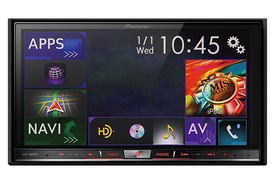
Features
Units like this new Pioneer AVIC-8000NEX (discontinued) fit most vehicles with the right parts and greatly improves the looks and functionality of your dash. DVD playback, smartphone compatibility, navigation, are all features you can have when adding an aftermarket head unit.
You can see how this is a popular first upgrade for your sound system. You can even add external monitors and sources such as headrest TVs or a backup camera. Adding an aftermarket radio also makes it easier to add external amplifiers.
Sound Quality
Not only do aftermarket radios offer better features, they usually offer better sound quality, too. Most stock head units have cheap DACs (digital to analog converters). When you upgrade your head unit, most of the time you are upgrading the DAC as well. Units like the Pioneer DEH-80PRS ($324 on Amazon with Prime shipping) offer three separate Burr-Brown DACS and 3 volt RCA outputs for the ultimate in sound quality.
Louder Sound
Aftermarket units also offer more power than stock head units (not stock amplified systems, though). Most factory radios have around 5-10 watts RMS per channel on their built in amplifiers. Most aftermarket radios offer around 15-18 watts RMS per channel (although they advertise 50W; this is a max power rating, though).
Subwoofers/Amplifiers
Subs are probably the next most popular upgrade whether it be for sound quality or SPL (sound pressure level, aka loud).
Sound Quality (SQ)
Subwoofers are not just to make loud boomy noises. They also greatly increase the sound quality in a few different ways.
One way they help with sound quality is they introduce low frequency sounds that most factory speakers or even aftermarket mid range drivers can’t reproduce clearly. This lets you hear low sounds that you couldn’t hear before that add depth and richness to your music.
Another way they help with SQ is take bass out of your mid range speakers. Most factory systems have full range speakers. This means the signal going to them consists of the very low frequencies and the very high frequencies that these speakers can’t produce. This makes them sound distorted when you try to play bass through them.
When you add a sub, you can set it to play the low frequencies only and set your other speakers to play only the frequencies higher than that. This allows each speaker to be within its sound reproduction range and makes everything much less distorted.
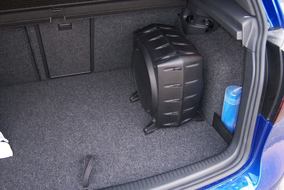
Sound Pressure Level (SPL)
Another popular use of subwoofers is to be loud. This is usually for people trying to show off or compete in SPL competitions. In these setups you usually have the biggest or most subs you can fit/afford with a lot of power going to them. These are the systems that go bump and wake your neighbors late at night.
Amplifiers
In order to add a sub, you have to have an amp to power it. Since head units usually only put out 50W max, you need to add a more powerful external amp to put out the higher power levels subs need since they are a much bigger driver than your typical 6.5″ speaker. Subs usually require at least 150W RMS to perform (depending on the driver).
Some people want to add a little bit of bass in a small package. Sub and amp combos like this Infinity Basslink ($230 on Amazon with Prime shipping) powered subwoofer have the amp built in and take up less room without sacrificing too much bass performance
Speakers/Amplifiers
The next upgrade step is usually the speakers, specifically the front. This can be done with or without adding another amp, but you will get much better performance in terms of quality and loudness with one. The front speakers come first because that is where the sound is being projected towards you, and setting up a good front stage can make it sound like a concert in your car. Rear speakers are usually just used for fill or not used at all when quality is your concern. For loudness, you’ll add all the speakers you can.
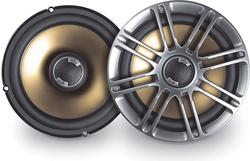
Coaxial Speakers
Coax speakers are the ones with the tweeter built into the center of the speaker like these Polk Audio db652‘s. This design allows for more simple installation than component speakers but still adds much better quality than factory speakers. These are a very popular choice due to being more inexpensive and easier/cheaper to install than component setups.
The tweeters are usually crossed over with the use of a capacitor which gives it a -6dB/octave slope at a fixed crossover point to block low frequencies from playing through, and damaging, the tweeter.
Component Speakers

Component speakers, or separates, are speaker setups that separate the tweeter from the mid range driver so the tweeter can be located to better improve sound quality. Since higher frequency sounds are easier to localize than low frequency sounds (hence why the sub is all the way in the trunk usually, the speakers are way down in the door panels, and the tweeters are up high), placing the tweeters closer to ear level and facing them at the driver raises the sound stage and greatly improves the sound quality.
Components usually come with an external crossover with a more advanced network than a single capacitor. These usually have a second or third order crossover set at a certain frequency offering steeper crossover slopes and usually consist of an L pad to dim the tweeters down a few dB to make them not as harsh.
Amplification
Speakers can be amplified with the head unit, but adding an external amp greatly increases output and sound quality. This is especially true when running components since the passive crossovers aren’t too efficient and require the recommended RMS power to sound best.
Basically, if you can afford it, do it.
These are the basics of sound system upgrades. Depending on your budget you can do one or all of them to improve your sound.
Conclusion
Now that you know the car audio basics, hopefully you have a better idea how everything works together as a system. This should give you some ideas on what route to take when upgrading your car audio system.
Check out my previous blog posts here to get an idea of next steps such as proper speaker installation, what NOT to do, and recommended tools for DIY car audio.
